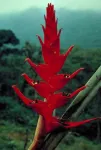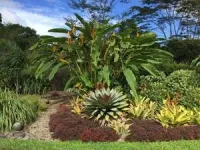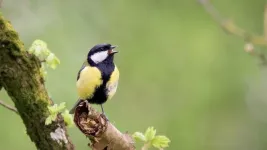The new work places Heliconia among a select group of plants to undergo a detailed, comprehensive conservation assessment. Traditionally such an effort requires countless hours of demanding fieldwork. Instead, the new project relied on previous field work conducted by research botanists like John Kress, an emeritus curator at the museum and one of the authors of the new study, who spent decades collecting Heliconia plants in the tropics. These efforts yielded thousands of dried specimens and data-rich labels that are housed in herbaria around the world, including the museum's United States National Herbarium.
“The data that is stored in the herbarium is a scientific treasure that makes a project like this feasible,” said botanist Gary Krupnick, who heads the museum’s Plant Conservation Unit and is one of Kress’ coauthors on the new study. “We built upon the valuable time and resources that past researchers have spent going out into the field and counting plant populations.”
Emblems of the Tropics
The genus Heliconia contains 187 species of tropical plants related to bananas. While a handful of Heliconia species are native to western Pacific islands, the majority live in rainforests throughout tropical Central and South America. Here, the plants are important ecological resources for a variety of creatures, including bats and hummingbirds, which are the primary pollinators for many Heliconia species. The plants produce nectar to entice the birds, who then spread pollen to other flowers as they flutter about.
Heliconia plants are famed for their flowers, which come in a variety of vivid hues, including intense yellows, fiery oranges and rosy reds. Their reproductive structures are composed of waxy, elongated leaves called bracts. Many Heliconia flowers resemble the striking plumage of birds-of-paradise. Others evoke lobster claws or toucan beaks.
Gardeners have cultivated Heliconia species for centuries as striking ornamental plants. This popularity has put some species at risk of overexploitation and poaching. In addition, Heliconia plants are threatened by habitat loss and fragmentation, invasive species and climate change.
Until now, little was known about Heliconia populations in the wild. Only a few Heliconia plants have undergone conservation assessments, and just 21 species of the charismatic flora are currently listed on the International Union for Conservation of Nature’s (IUCN) Red List of Threatened Species.
Herbarium Labels and Spatial Software
During the pandemic, Krupnick spent time sifting through herbarium sheets on the museum’s online collection database. While in-person access to the herbarium itself was limited, all Heliconia specimens in the museum’s collection had been fully digitized and were available online.
Krupnick became interested in exploring how Heliconia populations were faring in the wild and collaborated with Kress. At the time, Kress, who first encountered these plants in 1972 and became fascinated by their vibrant flowers during field work in Peru, was working with a group of scientists to publish a detailed description of Heliconia’s evolutionary history.
Kress and Krupnick used the dataset from this prior study and analyzed nearly 10,000 Heliconia specimens. Many of these dried plants, which Kress collected, were housed in the museum’s herbarium and mounted on large sheets of paper alongside labels that contain key information on when and where each plant was collected.
“As a conservation biologist, I’m most interested in the data on the label, which tells us the what, where, when and why,” Krupnick said. “This helps us track how populations change over time.”
The team used a spatial software tool called GeoCAT (Geospatial Conservation Assessment Tool) to calculate factors like range size and the abundance of plants occupying certain areas. The team then examined how human activities in these areas have impacted forest coverage using resources like satellite imagery. They also pinpointed which Heliconia populations occur in protected areas and which species exist in botanical gardens and could potentially be reintroduced into the wild.
Imperiled Plants
The team discovered that 87 Heliconia species (47% of the genus) are threatened with extinction, nearly half of the entire group. Alarmingly, all but one of these threatened species are found in only a few protected areas in the wild. And a relatively small number of these imperiled species exist outside their native ranges. The team discovered that the majority of Heliconia specimens growing in botanical gardens represent species of least conservation concern on the IUCN Red List.
The work also revealed that certain lineages within the Heliconia genus are particularly endangered. According to Kress, more work is needed to determine what makes these subsets of related species so vulnerable. But the overarching takeaway is clear.
“When you realize that whole evolutionary lineages of life with multiple species may be similarly threatened with extinction, it makes you stand up and notice that something is really happening here,” Kress said.
The researchers list 45 Heliconia species that they consider top priorities for additional protection. These include species that reside outside of protected areas and are not well represented in botanical gardens. It also highlights species that are adapted to thrive in fragile environments, such as high-altitude cloud forests that are particularly susceptible to change.
“This study provides a blueprint for how to save this group of plants, starting with this list of priority species,” Krupnick said.
Kress and Krupnick will attend an international meeting of Heliconia scientists and commercial growers in Hawaii at the end of March to contribute to efforts to conserve these plants. By raising public awareness and promoting responsible tourism, they hope to mitigate unsustainable production and demand for these plants. This would help alleviate pressures on wild populations of Heliconias and other endangered plant species.
The researchers also hope this project will inspire similar efforts to study other botanical groups. To date, less than 20% of all plant species have undergone conservation assessments. And without understanding the threatened statuses of certain groups, it remains difficult to chart a path forward.
“Now that we know the conservation status of every one of the 187 species of Heliconia, we can construct a coherent plan of how to protect them,” Kress said. “That does give me a tidbit of hope.”
In addition to Krupnick and Kress, Tomáš Fér of Charles University in Prague and Mónica Carlsen of the Missouri Botanical Garden were coauthors on the study.
About the National Museum of Natural History
The National Museum of Natural History is connecting people everywhere with Earth’s unfolding story. It is one of the most visited natural history museums in the world. Opened in 1910, the museum is dedicated to maintaining and preserving the world’s most extensive collection of natural history specimens and human artifacts. The museum is open daily, except Dec. 25, from 10 a.m. to 5:30 p.m. Admission is free. For more information, visit the museum on its website and blog and Facebook, LinkedIn and Instagram.
# # #
END





